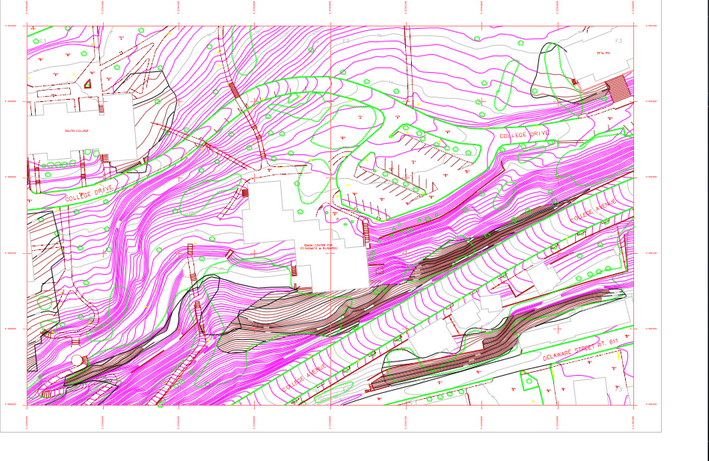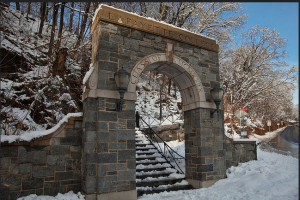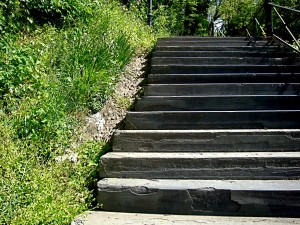Technical Analysis
In order to raise awareness for the restoration and renovation of travel methods to and from the Third St. Arts campus, a technical analysis must be utilized. Creating a better route for accessing hard to reach areas is usually a difficult task, therefore many factors were taken into consideration. Our first step in approaching the problem was to analyze the existing conditions of the current travel methods. The main stairwell from the back of Reuf and Keefe Halls to the bottom of the hill at the intersection of College Ave, Bushkill Dr. and Third St. has 90 steps. The total distance of this stairwell measured out to about 847 ft or roughly ⅙ of a mile (Oswald). However, since the stairwell is debatably a historical site, not much maintenance has been done over the years to keep the stairs in safe condition for students and faculty to travel on. With help from the Facilities and Planning Department we were able to locate a topographic map of college hill in order to analyze the slope of the hill.


Because of the significant slope of the hill (shown in maroon in the topographic image above), the steps have slanted at an undesirable grade over time. This deep slant of the steps pose as a high safety risk, especially during inclement weather. In addition to the slant of the stairs, the condition of the concrete and stone around the stairwell is in very poor condition. The steps are currently in a crumbling state with cracks, weeds, debris, and trash surrounding the area. Surrounded by poisonous weeds such as poison ivy poses a health threat for travelers on the stairs and is an alarming concern that needs to be paid attention to. The state of the steps and railings on the stair path is also another factor that needed to be taken into consideration as well. the railings have been rusted over, and many steps are cracked and loosely fit into the ground.

There were several technical factors for the three alternatives that we looked into.
Shuttle Bus:
The current busses that shuttle on continuous intervals to and from the Third St. campus are leased through the Palmeri Bus company. According to representatives from Palmeri, the busses drive about 76 loops a day on a 1.2 mile loop around campus. Although the busses are less economically demanding with initial costs, they do require constant funding for fuel and for renting the actual busses. A negative factor about the bus shuttle alternative its inefficiency. Lafayette has been working over the years to become an eco-friendly and sustainable campus, and utilizing bus shuttles on constant loops throughout the day is not an ideal “green” solution.
Funicular:
Another alternative that we looked into was the implementation of a funicular on the side of the hill. “A funicular is an overload rail-bound transport mechanism used to ascend and descend steep hillsides” (tech clinic). This option provides the fastest travel between the two campuses but would require difficult implementation along with regular maintenance. “Beyond the initial cost of excavation and construction, such an elevator would require a great deal of maintenance to ensure that it continues properly” (Tech Clinic) One of the biggest difficulties of the implementation of a funicular would be accessing the hill to construct on. The terrain is rocky, wooded, and rough on a very steep slope; this creates a difficult canvas for construction and would likely raise construction costs for such a technology.
Stairs:
Our third and most popular alternative for accessing the Third St. campus is the renovation of the steps. Because of the poor condition of the current steps, we feel that the total reconstruction of the steps would be effective. Since the current steps on the hill are at such a steep grade, a total reconstruction of the area would most likely have to occur rather than smaller scale reparations. This alternative would ultimately provide a clean solution with low maintenance costs and would encourage the lafayette community to walk from campus to campus. However, with the renovation or construction of new stairs would require strict compliance to the ADA ( Americans with Disabilities Act) guidelines. Although the guidelines do not directly address pathways between buildings, Mary Wilford-Hunt, Director of Facilities Planning and Construction at Lafayette, stated that the school would still consider accessibility factors if the steps were to be repaired.
Informational Video:
In order for this project to be successful, our group has decided that an informational video will be created with the purpose of further informing the Lafayette community of the hazards that surround the main stairs and the economic dilemmas with the Palmeri bus shuttle solution. Our hopes are that by our informing the Lafayette community of this issue, we will be able to jump start the improvement of the steps that lead to the bottom of the hill. In the constructing of the video, we decided that random student interviews along with anonymous student surveys would be helpful
One of our efforts in obtaining more information about the technical process for our project was interviewing Mary Wilford-Hunt from the Facilities planning and Construction Department here at Lafayette. In the interview, Mrs. Wilford-Hunt was asked a series of questions about the technical and economic components to the connection of the Third St. campus. the transcript to the interview can be found below.
Interview Transcript
Conducted by: Mazi Chiles
Interviewee: Mary Wilford-Hunt, Director of Facilities Planning and Construction
Chiles: Has the school considered addressing the steps leading from the main campus to the arts campus?
Wilford-Hunt: We have. We realized the increase of importance about the pedestrian length between the main campus and North 3rd st. especially because we are building and developing down at the base of the hill. So with the increased population will cause increased demands. So it is something that we discussed. The college has added some lighting and has done some minor improvements that you may or may not have noticed, but certainly there is always room for our continued improvement.
Chiles: We’ve heard of the school being concerned over some ADA requirements that would need to be considered if the school was to renovate the steps. Can you expand on those?
Wilford-Hunt: Yes, so we are in the midst of doing a campus wide ADA study. We take accessibility very seriously and want to make sure that we are in compliance wherever it is technically possible. And as a part of that study we have asked our consultants about what we call travel ways, which is getting from building to building and point to point on campus in addition to making the interior of each building accessible. So what is required by the mother of the law and the American Disabilities Act is that buildings have an accessible route from handicapped parking into the main areas of each building. So it does not address the paths in between buildings but that isn’t to say that we should not be looking into that as well.
Chiles: What is the process for a major project to be funded and approved? For example, a funicular option or a step renovation,
Wilford-Hunt: Right, so there are a couple of ways that that happens. One is through the Capital Request process and I think you heard a little bit about that from some of your classmates. So with the assistance of professor Cohen they filled out the Capital Project Request form, which you can find online, and its just a one page form but it starts the process rolling. It’s a way to get proposed projects on the list for consideration. So I would recommend you take a look at that form, I am very happy to help you out with that form and I would encourage you to do that immediately.
Chiles: Is that form for any type of project? For example would it be used by a member of the school, if you decided that we really need to address the steps. Would you go through the same process?
Wilford-Hunt: I would, because it’s a way to request funding for a project.
Chiles: Okay
Wilford-Hunt: So I’ve filled out quite a few of them for consideration for funding.
Chiles: And what is the alternate process that you suggested?
Wilford-Hunt: So another way would be if our president or a board member would propose something at a trustee meeting for consideration. So that’s kind of a top-down approach rather than a down up approach. But I think that for this project the Capital Request form would be appropriate. And like I said, I would be more than happy to help with that.
Chiles: Has the school gotten any estimates on how much a step renovation would cost?
Wilford-Hunt: We have not. And one of the reasons that we have not is obviously that those estimates would depend on the scope of work.
Chiles: Right
Wilford-Hunt: So it can be a simple pair of advisors for the treads to be placed or it could be a whole scale replacement instance of the path or anything in between. So we don’t have any numbers but we could easily get up to a million dollars on these steps.
Chiles: You believe it could be a million dollar project?
Wilford-Hunt: It could be, yeah.
Chiles: and that would be more if you were to take them out and re-build them.
Wilford-Hunt: Right. The handrails, additional lighting, new steps… and one of the reasons it can be so expensive is because it is so tricky to access the site. You cant get a truck anywhere near there.
Chiles: Well you already answered one of my questions, which was: As the art campus expands, do you think that the pressure to address the transition would increase, but how likely do you think the school would be to approve a costly solution such as a funicular or bridge in the near future?
Wilford-Hunt: I think that’s hard to answer. I think it depends on what other projects are proposed and what funds are available.
Chiles: Okay, well that actually concludes my set of questions. Thank you Professor.


Leave a Reply